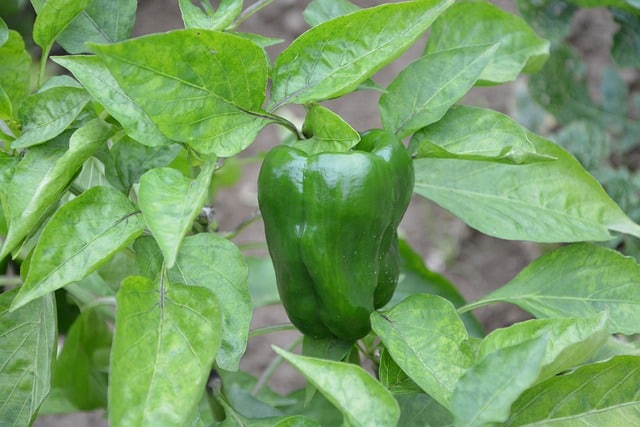Brown spots on pepper leaves can be an indication of a variety of problems. These spots can be caused by pests, diseases, or environmental factors. It is important to identify the underlying cause of the spots in order to properly treat and prevent further damage to the plant.
Understanding the causes of brown spots on pepper leaves is crucial in order to effectively manage the issue. Some of the most common causes of these spots include bacterial leaf spot, anthracnose, and sunscald.
These issues can be caused by a variety of factors including overwatering, poor air circulation, and nutrient deficiencies. Identifying the specific cause of the brown spots is the first step in treating the problem and preventing further damage to the plant.
Key Takeaways
- Brown spots on pepper leaves can be caused by pests, diseases, or environmental factors.
- Identifying the specific cause of the brown spots is crucial in order to effectively manage the issue.
- Proper prevention strategies and treatment options can help prevent further damage to the plant.
Related posts:
Understanding Brown Spots on Pepper Leaves
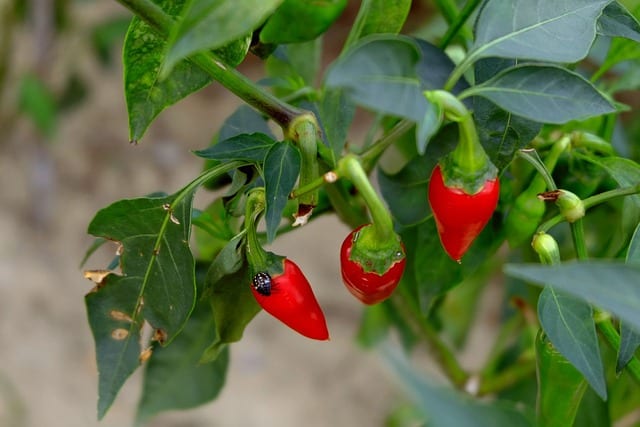
Brown spots on pepper leaves are a common problem that can be caused by various factors, including pests, diseases, and environmental stressors. These spots can affect the health and productivity of the plant, so it’s important to understand their causes and how to prevent and treat them.
One of the most common causes of brown spots on pepper leaves is bacterial leaf spot, which is a bacterial disease that can affect both sweet and hot peppers. This disease initially appears as water-soaked lesions on the leaves that turn brown and irregular in shape.
As the disease progresses, the spots may develop gray to tan centers with darker borders. To prevent and control bacterial leaf spot, it’s important to practice good sanitation by removing and destroying infected plant debris, avoiding overhead watering, and using copper-based fungicides.
Another common cause of brown spots on pepper leaves is sunscald, which is a type of leaf burn that occurs when the plant is exposed to too much direct sunlight. This can cause the leaves to develop white spots that are burned, dried out leaf tissue that is dead.
To prevent sunscald, it’s important to provide the plants with some shade during the hottest part of the day and to avoid over-fertilizing, which can make the plant more susceptible to sun damage.
In addition to these causes, brown spots on pepper leaves can also be caused by nutrient deficiencies, such as a lack of calcium or magnesium, or by pests, such as spider mites or thrips.
To prevent nutrient deficiencies, it’s important to provide the plants with a balanced fertilizer that contains all the necessary nutrients. To control pests, it’s important to use insecticidal soap or neem oil and to practice good sanitation by removing and destroying infected plant debris.
Overall, brown spots on pepper leaves can be a sign of various problems that can affect the health and productivity of the plant. By understanding the causes of these spots and taking steps to prevent and control them, gardeners can help ensure that their pepper plants remain healthy and productive.
Brown Spots on Pepper Leaves – 5 Common Problems
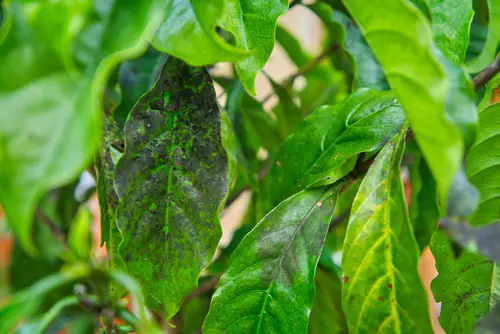
Brown spots on pepper leaves can be caused by various factors, including bacterial leaf spot, anthracnose, phytophthora blight, sunscald, and calcium deficiency.
1. Bacterial Leaf Spot
Bacterial leaf spot, caused by the bacterium Xanthomonas campestris pv. vesicatoria, is a common issue that affects pepper plants. The bacterium usually travels on transplants and seeds, and can overwinter in warm, moist environments with poor ventilation.
Symptoms of bacterial leaf spot include brown or black spots on pepper leaves, which can eventually cause the leaves to drop off.
2. Anthracnose
Anthracnose is a fungal disease that can cause brown spots on pepper leaves. The fungus usually infects the plant through wounds or natural openings, such as stomata. Symptoms of anthracnose include brown or black spots on pepper leaves, which can eventually cause the leaves to turn yellow and drop off.
3. Phytophthora Blight
Phytophthora blight, caused by the water mold Phytophthora capsici, is a serious disease that can affect pepper plants. The disease can be spread through contaminated soil, water, or plant debris. Symptoms of phytophthora blight include brown spots on pepper leaves, which can eventually cause the leaves to wilt and drop off.
4. Sunscald
Sunscald is a common issue that affects pepper plants. It occurs when the plant is exposed to too much sunlight, causing the leaves to become burned and brown. Improper hardening off can also lead to sunscald.
Symptoms of sunscald include white spots on pepper leaves, which are burned, dried out leaf tissue that is dead. The affected parts of the pepper leaves will crumble when squeezed and will not regain their green color.
5. Calcium Deficiency
Calcium deficiency is a common issue that affects pepper plants. It can cause brown spots on pepper leaves, which can eventually cause the leaves to drop off. Calcium deficiency can be caused by a lack of calcium in the soil or by an imbalance of other nutrients in the soil.
Symptoms of calcium deficiency include brown spots on pepper leaves, which can eventually cause the leaves to turn yellow and drop off.
Symptoms and Identification
Leaf Symptoms
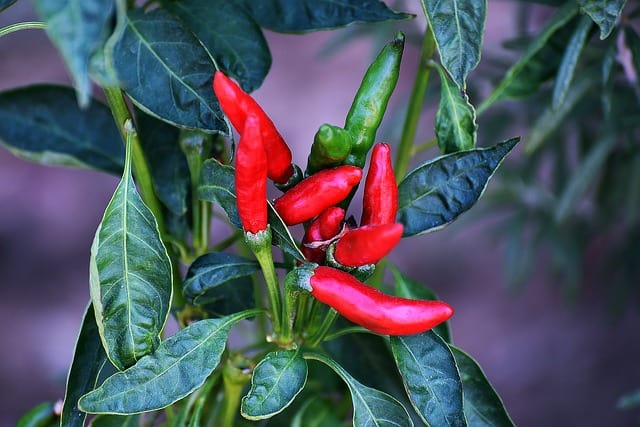
Brown spots on pepper leaves are a common issue that can be caused by several factors. The spots may appear as dark brown or black lesions, or they may be yellow or green spots with a dark border. In severe cases, the leaves may curl and become distorted.
One of the most common causes of brown spots on pepper leaves is bacterial leaf spot. This disease is caused by the Xanthomonas campestris bacteria, which can be spread by water, wind, or insects.
The spots caused by bacterial leaf spot are usually small and angular, with a yellow halo around them. As the disease progresses, the spots may merge and become larger, eventually causing the leaves to turn yellow and fall off.
Another cause of brown spots on pepper leaves is sunscald. This occurs when the leaves are exposed to too much direct sunlight, causing them to become dry and burnt. The affected areas may appear as white or yellow spots that eventually turn brown and crumble when touched.
Fruit Symptoms
Brown spots may also appear on developing pepper fruits. These spots may be corky or dark brown and may cause the fruit to become misshapen or stunted.
One common cause of fruit spots is blossom end rot, which is caused by a calcium deficiency in the plant. This condition can be prevented by ensuring that the plant has enough calcium and is watered regularly.
Another cause of fruit spots is bacterial spot, which is similar to bacterial leaf spot but affects the fruit instead of the leaves. The spots caused by bacterial spot may be raised and cracked, providing an entry point for other disease pathogens.
Overall, it is important to identify the cause of brown spots on pepper leaves and fruits in order to prevent further damage to the plant. Proper watering, fertilization, and pest management can help prevent many of these issues.
Effects on Pepper Plants
Brown spots on pepper leaves can have various effects on pepper plants, depending on the severity of the infection. If left untreated, infected plants may experience a reduction in yield, stunted growth, and even death.
Severely infected plants may experience leaf drop, which can lead to sunscald on the exposed fruit. Sunscald occurs when the fruit is exposed to direct sunlight, causing it to become discolored, deformed, and inedible.
In addition to leaf drop, infected plants may also experience fruit rot. Fruit rot is a condition where the fruit becomes soft, mushy, and discolored. This can render the fruit inedible and may lead to further spread of the infection.
Pepper plants that are infected with rot may also experience root rot. Root rot is a condition where the roots of the plant become infected, leading to a reduction in the plant’s ability to absorb nutrients and water. This can lead to stunted growth and reduced yield.
To prevent the spread of infection, it is important to remove infected plants and dispose of them properly. Additionally, it is important to maintain proper sanitation practices, such as cleaning tools and equipment between uses, to prevent the spread of infection between plants.
Prevention Strategies
Preventing brown spots on pepper leaves is essential to maintaining the health and productivity of pepper plants. Here are some strategies to help prevent brown spots on pepper leaves:
1. Proper Watering

Overwatering can lead to the development of brown spots on pepper leaves. It is important to water pepper plants deeply and infrequently, allowing the soil to dry out between watering.
The frequency of watering will depend on the climate, the size of the container or bed, and the drainage of the soil. In general, it is best to water peppers when the soil is dry to the touch. It is also important to ensure that the soil has good drainage to prevent water from accumulating around the roots.
2. Appropriate Sun Exposure
Direct sun can cause pepper leaves to develop brown spots. It is important to provide pepper plants with appropriate sun exposure. For potted plants, move them to a location that receives morning or late afternoon sun, and provide shade during the hottest part of the day.
For in-ground plants, use a floating row cover or other shade-providing methods to protect the plants from intense mid-day sun.
3. Healthy Soil and Fertilization
Healthy soil is essential for preventing brown spots on pepper leaves. Ensure that the soil is rich in organic matter and has good drainage. Fertilize pepper plants with a balanced fertilizer, following the manufacturer’s instructions.
Over-fertilization can lead to the development of brown spots on pepper leaves, so it is important to avoid using too much fertilizer.
4. Crop Rotation
Crop rotation can help prevent the development of brown spots on pepper leaves. Avoid planting peppers in the same location year after year, as this can lead to the buildup of soil-borne pathogens.
Instead, rotate the crops, planting peppers in a different location each year. This will help prevent the buildup of pathogens and maintain healthy soil.
By following these prevention strategies, gardeners can help prevent brown spots on pepper leaves and maintain healthy, productive pepper plants.
Treatment Options
When it comes to treating brown spots on pepper leaves, there are several options available. These include the use of fungicides and bactericides, neem oil and insecticidal soap, and beneficial insects.
1. Use of Fungicides and Bactericides
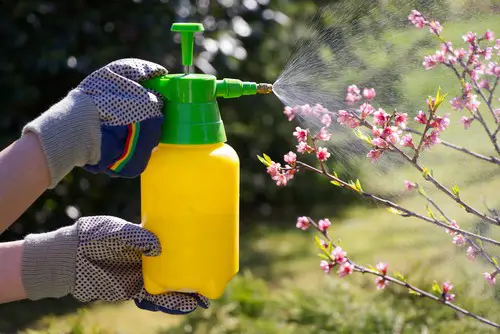
Fungicides and bactericides are effective treatments for brown spots caused by fungal or bacterial infections. Copper sulfate is a common fungicide that can be used to control fungal infections in pepper plants. It is best applied at the first sign of infection and should be reapplied every 7-10 days until the infection is under control.
Bactericides are used to control bacterial infections in pepper plants. They work by killing the bacteria that cause the infection. One effective bactericide is streptomycin sulfate. It is applied in the same manner as copper sulfate and should be reapplied every 7-10 days until the infection is under control.
2. Neem Oil and Insecticidal Soap
Neem oil and insecticidal soap are natural treatments for brown spots caused by pests. Neem oil is derived from the neem tree and is effective against a wide range of pests, including aphids, spider mites, and whiteflies. It works by disrupting the feeding and reproductive processes of the pests.
Insecticidal soap is another natural treatment for pests. It works by suffocating the pests and disrupting their cell membranes. It is effective against a wide range of pests, including aphids, spider mites, and whiteflies.
3. Beneficial Insects
Beneficial insects, such as ladybugs, can also be used to control pests in pepper plants. Ladybugs are natural predators of aphids and other pests. They can be purchased from garden centers and released into the garden to control pests.
Diatomaceous earth is another natural treatment for pests. It is a fine powder made from the fossilized remains of diatoms. It works by dehydrating the pests and disrupting their cell membranes.
Managing Pests
Pepper plants are susceptible to various pests that cause brown spots on their leaves. To manage these pests, it is important to identify the type of pest and use the appropriate control method. Here are some common pests that cause brown spots on pepper leaves and how to manage them.
1. Ants
Ants are not usually the primary cause of brown spots on pepper leaves, but they can attract other pests that cause damage. Ants are attracted to the sweet, sticky substance called honeydew that is excreted by some pests like aphids and mealybugs.
They protect these pests from predators and parasites, making it difficult to control them. To manage ants, it is important to control the primary pest that is attracting them. This can be done by using insecticidal soap or neem oil.
2. Caterpillars
Caterpillars are the larvae of moths and butterflies and can cause significant damage to pepper plants. They feed on the leaves, leaving behind brown spots and holes.
To manage caterpillars, it is important to inspect the plants regularly and remove any caterpillars by hand. Bacillus thuringiensis (Bt) is an effective biological control that can be used to manage caterpillars.
3. Slugs
Slugs are nocturnal pests that feed on the leaves of pepper plants, leaving behind brown spots and holes. They are attracted to moist environments and can be managed by reducing the moisture level around the plants.
This can be done by watering the plants in the morning, removing any debris or weeds around the plants, and using a slug bait.
4. Thrips
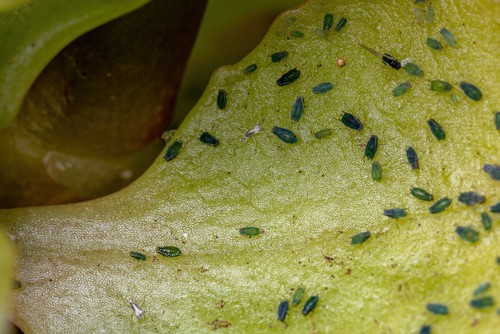
Thrips are tiny insects that feed on the sap of pepper plants, causing brown spots on the leaves. They are difficult to see with the naked eye and can be identified by their silver-grey color. To manage thrips, it is important to use insecticidal soap or neem oil. Yellow sticky traps can also be used to monitor and control thrips.
5. Whiteflies
Whiteflies are tiny, white insects that feed on the underside of pepper leaves, causing brown spots and yellowing. They excrete honeydew, attracting ants and other pests. To manage whiteflies, it is important to use insecticidal soap or neem oil. Yellow sticky traps can also be used to monitor and control whiteflies.
Insecticides should be used as a last resort and only when necessary. It is important to follow the instructions on the label and use the appropriate protective gear when handling insecticides.
Conclusion
When growing peppers, it is important to maintain proper growing conditions, including adequate watering, fertilization, and pest management. Growing peppers from seed or seedlings can provide a wider variety of pepper options, but it is important to ensure that the plants are healthy and free from disease before planting.
Pepper production can be a lucrative business, but it requires careful attention to detail and proper management techniques. Choosing the right pepper varieties for the growing conditions and market demand can help ensure a successful crop.
Frequently Asked Questions
How do you treat brown spots on pepper leaves?
Treatment for brown spots on pepper leaves depends on the cause. If the spots are caused by a fungal infection, removing the affected leaves and applying a fungicide can help.
If the spots are caused by a bacterial infection, removing the affected leaves and applying a copper-based fungicide can help.
If the spots are caused by a nutrient deficiency, fertilizing the plant with a balanced fertilizer can help. In general, it is important to keep the plant healthy and well-watered to prevent the spread of brown spots.
Why do my pepper plants have brown spots?
Pepper plants can develop brown spots for a variety of reasons, including fungal or bacterial infections, nutrient deficiencies, environmental stress, or insect damage. It is important to identify the cause of the brown spots in order to treat the problem effectively.
Are bell peppers with brown spots safe to eat?
While brown spots on bell peppers are not harmful to eat, they can affect the taste and texture of the pepper. It is best to remove the affected areas before using the pepper in cooking.
Why are the leaves on my pepper plants turning brown?
The leaves on pepper plants can turn brown for a variety of reasons, including fungal or bacterial infections, nutrient deficiencies, environmental stress, or insect damage. It is important to identify the cause of the brown spots in order to treat the problem effectively.
How to prevent brown spots on pepper leaves?
To prevent brown spots on pepper leaves, it is important to keep the plant healthy and well-watered. Providing adequate nutrition, proper spacing, and good air circulation can also help prevent fungal or bacterial infections.
Regularly inspecting the plant for signs of insect damage or disease can also help prevent brown spots from developing.
What are the causes of brown spots on pepper leaves?
Brown spots on pepper leaves can be caused by fungal or bacterial infections, nutrient deficiencies, environmental stress, or insect damage. It is important to identify the cause of the brown spots in order to treat the problem effectively.

Hey, I’m Lisa and I’ve been an avid gardener for over 30 years. I love writing, talking and living in the garden! Feel free to connect with me on my socials below

